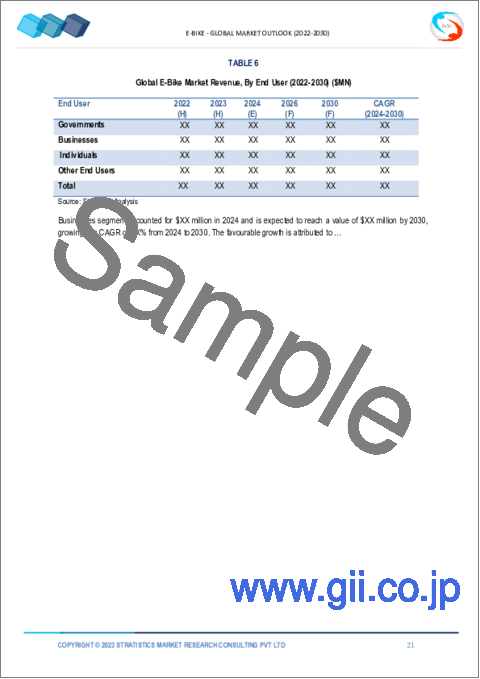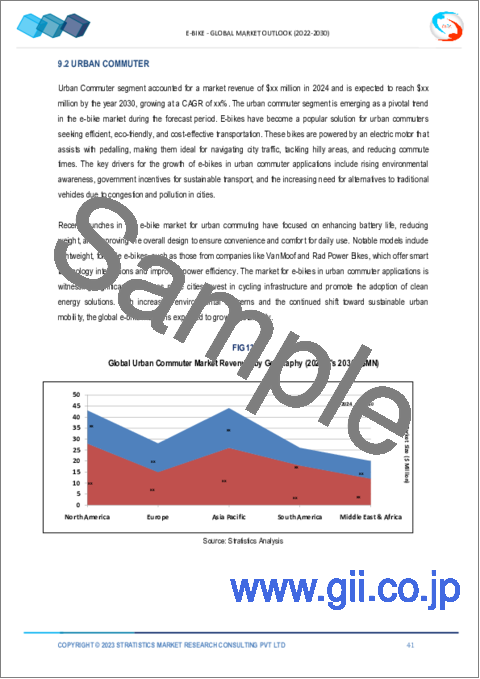|
|
市場調査レポート
商品コード
1530654
電動自転車市場の2030年までの予測: 製品タイプ、バッテリータイプ、モータータイプ、モード、用途、エンドユーザー、地域別の世界分析E-Bike Market Forecasts to 2030 - Global Analysis By Product Type (Pedal Assist, Throttle-Controlled, Speed Pedelecs, Cargo, Mountain, Folding and Other Product Types), Battery Type, Motor Type, Mode, Application, End User and By Geography |
||||||
カスタマイズ可能
|
|||||||
| 電動自転車市場の2030年までの予測: 製品タイプ、バッテリータイプ、モータータイプ、モード、用途、エンドユーザー、地域別の世界分析 |
|
出版日: 2024年08月01日
発行: Stratistics Market Research Consulting
ページ情報: 英文 200+ Pages
納期: 2~3営業日
|
- 全表示
- 概要
- 図表
- 目次
Stratistics MRCによると、世界の電動自転車市場は2024年に487億米ドルを占め、予測期間中のCAGRは8.6%で成長し、2030年には798億米ドルに達すると予測されています。
電動自転車は推進力を補助する電気モーターを内蔵しており、多くの場合、ペダリングやスロットルで作動します。これらの自転車は、伝統的なサイクリングと現代技術を融合させ、スピードと乗りやすさを向上させるさまざまなレベルの電動サポートを提供します。E-BIKEは一般的に充電式バッテリーを搭載し、ペダルアシスト式とスロットル操作式に分類され、環境負荷の低減とアクセシビリティの向上を実現した、環境に優しい代替交通手段を求める通勤者、レクリエーションサイクリスト、都市生活者に対応しています。
Light Electric Vehicle Association(LEVA)によると、e-bikeの輸入台数は2020年には45万台、2021年には79万台に増加し、流行前の2019年の需要25万台と比較すると、それぞれ約76%および80%の増加となっています。
超小型モビリティサービスの需要増加
市場は、超小型モビリティサービスへの関心の高まりによって需要が急増しています。環境意識の高まり、都市の混雑問題、より健康的な通勤手段への要望が、この上昇に拍車をかけています。各社は、この拡大する市場セグメントに対応するため、軽量設計、バッテリー寿命の向上、スマートな接続機能で技術革新を進めています。都市が持続可能なモビリティー・ソリューションを採用するにつれ、同市場は都市交通エコシステムにおける極めて重要なプレーヤーとして成長を続けています。
インフラの不足
市場が直面する大きな問題の一つは、幅広い普及を可能にする十分なインフラがないことです。これには、不十分な充電ステーション、限られた自転車専用レーン、地域によって一貫性のない規制の枠組みなどが含まれます。こうした要因は消費者の信頼と利便性を妨げ、市場の成長に影響を与えます。こうしたインフラ格差に対処するには、政府機関、都市計画立案者、民間利害関係者が協力して、堅牢な充電ネットワークを構築し、e-bikeの利用を奨励する支援政策を確立する必要があります。
環境持続性への関心の高まり
二酸化炭素の排出や都市の混雑に対する懸念が高まる中、電動自転車はよりクリーンで効率的な交通手段を提供します。メーカー各社は、環境への影響を軽減するため、環境に優しい素材や技術を設計に取り入れるようになってきています。政府や規制機関も、補助金やインフラ整備を通じて導入にインセンティブを与え、都市モビリティの環境に優しい未来を育成しています。
多様な政府規制
急速に成長する市場では、政府によるさまざまな規制が大きな課題となっています。これには、地域によって異なるe-bikeの分類、ライダーに対する免許要件の変動、バッテリー技術の安全基準の進化などが含まれます。この業界の製品設計と流通方法は、さまざまな規制状況を乗り切るために、各国特有のコンプライアンス戦術を開発・実施する必要性によって影響を受ける。
COVID-19の影響:
COVID-19の大流行は、環境にやさしく社会的に距離のある通勤手段への関心を喚起し、電動自転車市場を大きく押し上げました。公共交通機関が制限され、個人の移動手段が重視されるようになったため、世界的に販売が急増しました。消費者はより安全な代替手段を求め、レジャーや日常的な通勤に電動自転車の採用が増加しました。当初はサプライチェーンの混乱が生産に影響を与えたが、メーカー各社はオンライン販売チャネルを活用して需要増に迅速に対応しました。
予測期間中、ハブモーターセグメントが最大となる見込み
予測期間中、ハブモーターが最大となる見込みです。ハブモーターは、コンパクトな設計、静かな動作、メンテナンスの容易さなど、いくつかの利点があります。また、さまざまな出力定格や構成があり、自転車のタイプやユーザーの好みに合わせて選択できます。ハブモーターは、乗り心地を向上させ、あらゆる年齢層やフィットネスレベルのユーザーにとってサイクリングをより身近で楽しいものにすることで、e-bikeの人気拡大に大きく貢献しています。
予測期間中にCAGRが最も高くなると予想されるのは都市コミューター分野です。
予測期間中、CAGRが最も高くなると予想されるのは都市コミューターセグメントです。これらのバイクは通常、軽量フレーム、応答性の高い電動モーター、混雑した道路や狭いスペースの移動に理想的なコンパクト設計を特徴としています。人間工学に基づいた座席とハンドルバーの設定により快適性を優先し、先進モデルには統合ナビゲーションシステムやスマートコネクティビティオプションなどの機能が含まれることもあります。市場セグメンテーションは、効率的で環境に優しい交通手段を求める都市生活者に特化しています。
最大のシェアを占める地域:
予測期間中、北米が最大の市場シェアを占めると予測されます。消費者は、二酸化炭素排出量の削減や利便性の向上といった利点に惹かれて、通勤やレクリエーション目的でe-bikeを採用する傾向が強まっています。主要企業は、多様な消費者の嗜好に対応するため、バッテリーの効率性とデザインの技術的進歩に注力しています。規制支援と発展が市場拡大をさらに後押しし、世界のe-bike産業において極めて重要な地域となっています。
CAGRが最も高い地域:
アジア太平洋地域は、都市化の進展と持続可能な輸送ソリューションへのシフトにより、予測期間中最も高いCAGRを維持すると予測されます。環境問題への関心の高まりと持続可能な移動手段へのシフトも、市場の人気上昇に寄与しています。バッテリー技術、軽量素材、モーター効率の進歩により、e-bikeの性能と魅力が向上し、消費者にとってより魅力的なものとなっています。
無料カスタマイズサービス:
本レポートをご購読のお客様には、以下の無料カスタマイズオプションのいずれかをご提供いたします:
- 企業プロファイル
- 追加市場プレイヤーの包括的プロファイリング(3社まで)
- 主要企業のSWOT分析(3社まで)
- 地域セグメンテーション
- 顧客の関心に応じた主要国の市場推計・予測・CAGR(注:フィージビリティチェックによる)
- 競合ベンチマーキング
- 製品ポートフォリオ、地理的プレゼンス、戦略的提携に基づく主要企業のベンチマーキング
目次
第1章 エグゼクティブサマリー
第2章 序文
- 概要
- ステークホルダー
- 調査範囲
- 調査手法
- データマイニング
- データ分析
- データ検証
- 調査アプローチ
- 調査情報源
- 1次調査情報源
- 2次調査情報源
- 前提条件
第3章 市場動向分析
- 促進要因
- 抑制要因
- 機会
- 脅威
- 製品分析
- 用途分析
- エンドユーザー分析
- 新興市場
- COVID-19の影響
第4章 ポーターのファイブフォース分析
- 供給企業の交渉力
- 買い手の交渉力
- 代替品の脅威
- 新規参入業者の脅威
- 競争企業間の敵対関係
第5章 世界の電動自転車市場:製品タイプ別
- ペダルアシスト
- スロットル制御
- スピードペデレック
- 貨物
- マウンテン
- 折りたたみ
- その他の製品タイプ
第6章 世界の電動自転車市場:バッテリータイプ別
- リチウムイオン電池
- 鉛蓄電池
- ニッケルカドミウム電池
- ニッケル水素電池
第7章 世界の電動自転車市場:モータータイプ別
- ハブモーター
- ミッドドライブモーター
- 摩擦駆動モーター
第8章 世界の電動自転車市場:モード別
- 通勤
- スポーツ
- ユーティリティ
第9章 世界の電動自転車市場:用途別
- 都市通勤者
- 山
- 折りたたみ
- 配送サービス
- その他の用途
第10章 世界の電動自転車市場:エンドユーザー別
- 政府
- 企業
- 個人
- その他のエンドユーザー
第11章 世界の電動自転車市場:地域別
- 北米
- 米国
- カナダ
- メキシコ
- 欧州
- ドイツ
- 英国
- イタリア
- フランス
- スペイン
- その他欧州
- アジア太平洋
- 日本
- 中国
- インド
- オーストラリア
- ニュージーランド
- 韓国
- その他アジア太平洋地域
- 南米
- アルゼンチン
- ブラジル
- チリ
- その他南米
- 中東・アフリカ
- サウジアラビア
- アラブ首長国連邦
- カタール
- 南アフリカ
- その他中東とアフリカ
第12章 主な発展
- 契約、パートナーシップ、コラボレーション、合弁事業
- 買収と合併
- 新製品発売
- 事業拡大
- その他の主要戦略
第13章 企業プロファイリング
- Giant Bicycles
- Trek Bicycle Corporation
- Specialized Bicycle Components
- Riese & Muller
- Rad Power Bikes
- Cannondale
- Cube Bikes
- Pedego Electric Bikes
- Merida Industry Co., Ltd.
- Scott Sports
- Yamaha Motor Company
- Brompton Bicycle
- Aventon Bikes
- Bulls Bikes USA
- Ancheer
- Tern Bicycles
- Xiaomi
List of Tables
- Table 1 Global E-Bike Market Outlook, By Region (2022-2030) ($MN)
- Table 2 Global E-Bike Market Outlook, By Product Type (2022-2030) ($MN)
- Table 3 Global E-Bike Market Outlook, By Pedal Assist (2022-2030) ($MN)
- Table 4 Global E-Bike Market Outlook, By Throttle-Controlled (2022-2030) ($MN)
- Table 5 Global E-Bike Market Outlook, By Speed Pedelecs (2022-2030) ($MN)
- Table 6 Global E-Bike Market Outlook, By Cargo (2022-2030) ($MN)
- Table 7 Global E-Bike Market Outlook, By Mountain (2022-2030) ($MN)
- Table 8 Global E-Bike Market Outlook, By Folding (2022-2030) ($MN)
- Table 9 Global E-Bike Market Outlook, By Other Product Types (2022-2030) ($MN)
- Table 10 Global E-Bike Market Outlook, By Battery Type (2022-2030) ($MN)
- Table 11 Global E-Bike Market Outlook, By Lithium-ion Battery (2022-2030) ($MN)
- Table 12 Global E-Bike Market Outlook, By Lead Acid Battery (2022-2030) ($MN)
- Table 13 Global E-Bike Market Outlook, By Nickel-Cadmium Battery (2022-2030) ($MN)
- Table 14 Global E-Bike Market Outlook, By Nickel-Metal Hydride Battery (2022-2030) ($MN)
- Table 15 Global E-Bike Market Outlook, By Motor Type (2022-2030) ($MN)
- Table 16 Global E-Bike Market Outlook, By Hub Motor (2022-2030) ($MN)
- Table 17 Global E-Bike Market Outlook, By Mid Drive Motor (2022-2030) ($MN)
- Table 18 Global E-Bike Market Outlook, By Friction Drive Motor (2022-2030) ($MN)
- Table 19 Global E-Bike Market Outlook, By Mode (2022-2030) ($MN)
- Table 20 Global E-Bike Market Outlook, By Commute (2022-2030) ($MN)
- Table 21 Global E-Bike Market Outlook, By Sports (2022-2030) ($MN)
- Table 22 Global E-Bike Market Outlook, By Utility (2022-2030) ($MN)
- Table 23 Global E-Bike Market Outlook, By Application (2022-2030) ($MN)
- Table 24 Global E-Bike Market Outlook, By Urban Commuter (2022-2030) ($MN)
- Table 25 Global E-Bike Market Outlook, By Mountain (2022-2030) ($MN)
- Table 26 Global E-Bike Market Outlook, By Folding (2022-2030) ($MN)
- Table 27 Global E-Bike Market Outlook, By Delivery Services (2022-2030) ($MN)
- Table 28 Global E-Bike Market Outlook, By Other Applications (2022-2030) ($MN)
- Table 29 Global E-Bike Market Outlook, By End User (2022-2030) ($MN)
- Table 30 Global E-Bike Market Outlook, By Governments (2022-2030) ($MN)
- Table 31 Global E-Bike Market Outlook, By Businesses (2022-2030) ($MN)
- Table 32 Global E-Bike Market Outlook, By Individuals (2022-2030) ($MN)
- Table 33 Global E-Bike Market Outlook, By Other End Users (2022-2030) ($MN)
Note: Tables for North America, Europe, APAC, South America, and Middle East & Africa Regions are also represented in the same manner as above.
According to Stratistics MRC, the Global E-Bike Market is accounted for $48.7 billion in 2024 and is expected to reach $79.8 billion by 2030 growing at a CAGR of 8.6% during the forecast period. An e-bike, short for electric bicycle, integrates an electric motor to assist propulsion, often activated through pedaling or a throttle. These bikes blend traditional cycling with modern technology, offering varying levels of motorized support to enhance speed and ease of riding. E-bikes commonly feature rechargeable batteries and can be categorized into pedal-assist and throttle-operated models, catering to commuters, recreational cyclists, and urban dwellers seeking eco-friendly transportation alternatives with reduced environmental impact and increased accessibility.
According to the Light Electric Vehicle Association (LEVA), the imports of e-bikes increased to 450,000 Units in 2020 and 790,000 in 2021, an increase of around 76% & 80%, respectively, compared to the pre-pandemic demand of 250,000 units in 2019.
Market Dynamics:
Driver:
Rising demand for micro-mobility services
The market is experiencing a surge in demand driven by increasing interest in micro-mobility services. The rise is fueled by growing environmental awareness, urban congestion issues, and the desire for healthier commuting options. Companies are innovating with lightweight designs, enhanced battery life, and smart connectivity features to cater to this expanding market segment. As cities embrace sustainable mobility solutions, the market continues to grow as a pivotal player in urban transportation ecosystems.
Restraint:
Lack of infrastructure
One of the major issues facing the market is the absence of sufficient infrastructure to enable broad adoption. This includes insufficient charging stations, limited dedicated bike lanes, and inconsistent regulatory frameworks across regions. These factors hinder consumer confidence and convenience, impacting market growth. Addressing these infrastructure gaps requires collaboration between government bodies, urban planners, and private stakeholders to build robust charging networks and establish supportive policies that encourage e-bike usage.
Opportunity:
Increasing focus on environmental sustainability
With growing concerns over carbon emissions and urban congestion, electric bicycles offer a cleaner and more efficient mode of transportation. Manufacturers are increasingly integrating eco-friendly materials and technologies into their designs, aiming to reduce environmental impact. Governments and regulatory bodies are also incentivizing adoption through subsidies and infrastructure development, fostering a greener future for urban mobility.
Threat:
Varied government regulations
In the rapidly growing market, diverse government regulations present significant challenges. These include varying classifications of e-bikes across different regions, fluctuating licensing requirements for riders, and evolving safety standards for battery technologies. Product design and distribution methods in this industry are impacted by the need to develop and implement compliance tactics specific to each nation in order to navigate various regulatory landscapes.
Covid-19 Impact:
The COVID-19 pandemic significantly boosted the E-Bike market as it spurred interest in eco-friendly and socially distanced commuting options. With restrictions on public transport and a growing emphasis on personal mobility, sales surged globally. Consumers sought safer alternatives, leading to increased adoption of electric bikes for leisure and daily commuting. Supply chain disruptions initially impacted production, but manufacturers adapted swiftly, leveraging online sales channels to meet rising demand.
The hub motor segment is expected to be the largest during the forecast period
The hub motor is expected to be the largest during the forecast period. These motors offer several advantages, including compact design, quiet operation, and ease of maintenance. They are available in various power ratings and configurations to suit different bike types and user preferences. Hub motors contribute significantly to the growing popularity of e-bikes by enhancing ride comfort and making cycling more accessible and enjoyable for users of all ages and fitness levels.
The urban commuter segment is expected to have the highest CAGR during the forecast period
The urban commuter segment is expected to have the highest CAGR during the forecast period. These bikes typically feature lightweight frames, responsive electric motors, and compact designs ideal for navigating crowded streets and tight spaces. They prioritize comfort with ergonomic seating and handlebar setups, while advanced models may include features like integrated navigation systems and smart connectivity options. The segment in the market caters specifically to city dwellers seeking efficient, eco-friendly transportation solutions.
Region with largest share:
North America is projected to hold the largest market share during the forecast period. Consumers are increasingly adopting e-bikes for commuting and recreational purposes, attracted by benefits such as reduced carbon emissions and enhanced convenience. Key players are focusing on technological advancements in battery efficiency and design to cater to diverse consumer preferences. Regulatory support and infrastructure developments further bolster market expansion, positioning as a pivotal region in the global e-bike industry.
Region with highest CAGR:
Asia Pacific is projected to hold the highest CAGR over the forecast period driven by increasing urbanization and a shift towards sustainable transportation solutions. Growing environmental concerns and a shift towards sustainable mobility options have also contributed to the rising popularity of the market. Advances in battery technology, lightweight materials, and motor efficiency have improved the performance and appeal of e-bikes, making them more attractive to consumers.
Key players in the market
Some of the key players in E-Bike market include Giant Bicycles, Trek Bicycle Corporation, Specialized Bicycle Components, Riese & Muller, Rad Power Bikes, Cannondale, Cube Bikes, Pedego Electric Bikes, Merida Industry Co., Ltd., Scott Sports, Yamaha Motor Company, Brompton Bicycle, Aventon Bikes, Bulls Bikes USA, Ancheer, Tern Bicycles and Xiaomi.
Key Developments:
In April 2024, Pedego launched its Fat Tire Trike e-bike with three tires and a low-step frame design. It is equipped with PEDALSENSE, propulsion software that provides various riding options, such as throttle drive, torque assist, and cruise assist.
In March 2024, Pedego launched its Pedego MOTO, which is equipped with both front and rear suspensions to provide comfort on rugged terrain. A 48V battery producing 750W powers it.
Product Types Covered:
- Pedal Assist
- Throttle-Controlled
- Speed Pedelecs
- Cargo
- Mountain
- Folding
- Other Product Types
Battery Types Covered:
- Lithium-ion Battery
- Lead Acid Battery
- Nickel-Cadmium Battery
- Nickel-Metal Hydride Battery
Motor Types Covered:
- Hub Motor
- Mid Drive Motor
- Friction Drive Motor
Modes Covered:
- Commute
- Sports
- Utility
Applications Covered:
- Urban Commuter
- Mountain
- Folding
- Delivery Services
- Other Applications
End Users Covered:
- Governments
- Businesses
- Individuals
- Other End Users
Regions Covered:
- North America
- US
- Canada
- Mexico
- Europe
- Germany
- UK
- Italy
- France
- Spain
- Rest of Europe
- Asia Pacific
- Japan
- China
- India
- Australia
- New Zealand
- South Korea
- Rest of Asia Pacific
- South America
- Argentina
- Brazil
- Chile
- Rest of South America
- Middle East & Africa
- Saudi Arabia
- UAE
- Qatar
- South Africa
- Rest of Middle East & Africa
What our report offers:
- Market share assessments for the regional and country-level segments
- Strategic recommendations for the new entrants
- Covers Market data for the years 2022, 2023, 2024, 2026, and 2030
- Market Trends (Drivers, Constraints, Opportunities, Threats, Challenges, Investment Opportunities, and recommendations)
- Strategic recommendations in key business segments based on the market estimations
- Competitive landscaping mapping the key common trends
- Company profiling with detailed strategies, financials, and recent developments
- Supply chain trends mapping the latest technological advancements
Free Customization Offerings:
All the customers of this report will be entitled to receive one of the following free customization options:
- Company Profiling
- Comprehensive profiling of additional market players (up to 3)
- SWOT Analysis of key players (up to 3)
- Regional Segmentation
- Market estimations, Forecasts and CAGR of any prominent country as per the client's interest (Note: Depends on feasibility check)
- Competitive Benchmarking
- Benchmarking of key players based on product portfolio, geographical presence, and strategic alliances
Table of Contents
1 Executive Summary
2 Preface
- 2.1 Abstract
- 2.2 Stake Holders
- 2.3 Research Scope
- 2.4 Research Methodology
- 2.4.1 Data Mining
- 2.4.2 Data Analysis
- 2.4.3 Data Validation
- 2.4.4 Research Approach
- 2.5 Research Sources
- 2.5.1 Primary Research Sources
- 2.5.2 Secondary Research Sources
- 2.5.3 Assumptions
3 Market Trend Analysis
- 3.1 Introduction
- 3.2 Drivers
- 3.3 Restraints
- 3.4 Opportunities
- 3.5 Threats
- 3.6 Product Analysis
- 3.7 Application Analysis
- 3.8 End User Analysis
- 3.9 Emerging Markets
- 3.10 Impact of Covid-19
4 Porters Five Force Analysis
- 4.1 Bargaining power of suppliers
- 4.2 Bargaining power of buyers
- 4.3 Threat of substitutes
- 4.4 Threat of new entrants
- 4.5 Competitive rivalry
5 Global E-Bike Market, By Product Type
- 5.1 Introduction
- 5.2 Pedal Assist
- 5.3 Throttle-Controlled
- 5.4 Speed Pedelecs
- 5.5 Cargo
- 5.6 Mountain
- 5.7 Folding
- 5.8 Other Product Types
6 Global E-Bike Market, By Battery Type
- 6.1 Introduction
- 6.2 Lithium-ion Battery
- 6.3 Lead Acid Battery
- 6.4 Nickel-Cadmium Battery
- 6.5 Nickel-Metal Hydride Battery
7 Global E-Bike Market, By Motor Type
- 7.1 Introduction
- 7.2 Hub Motor
- 7.3 Mid Drive Motor
- 7.4 Friction Drive Motor
8 Global E-Bike Market, By Mode
- 8.1 Introduction
- 8.2 Commute
- 8.3 Sports
- 8.4 Utility
9 Global E-Bike Market, By Application
- 9.1 Introduction
- 9.2 Urban Commuter
- 9.3 Mountain
- 9.4 Folding
- 9.5 Delivery Services
- 9.6 Other Applications
10 Global E-Bike Market, By End User
- 10.1 Introduction
- 10.2 Governments
- 10.3 Businesses
- 10.4 Individuals
- 10.5 Other End Users
11 Global E-Bike Market, By Geography
- 11.1 Introduction
- 11.2 North America
- 11.2.1 US
- 11.2.2 Canada
- 11.2.3 Mexico
- 11.3 Europe
- 11.3.1 Germany
- 11.3.2 UK
- 11.3.3 Italy
- 11.3.4 France
- 11.3.5 Spain
- 11.3.6 Rest of Europe
- 11.4 Asia Pacific
- 11.4.1 Japan
- 11.4.2 China
- 11.4.3 India
- 11.4.4 Australia
- 11.4.5 New Zealand
- 11.4.6 South Korea
- 11.4.7 Rest of Asia Pacific
- 11.5 South America
- 11.5.1 Argentina
- 11.5.2 Brazil
- 11.5.3 Chile
- 11.5.4 Rest of South America
- 11.6 Middle East & Africa
- 11.6.1 Saudi Arabia
- 11.6.2 UAE
- 11.6.3 Qatar
- 11.6.4 South Africa
- 11.6.5 Rest of Middle East & Africa
12 Key Developments
- 12.1 Agreements, Partnerships, Collaborations and Joint Ventures
- 12.2 Acquisitions & Mergers
- 12.3 New Product Launch
- 12.4 Expansions
- 12.5 Other Key Strategies
13 Company Profiling
- 13.1 Giant Bicycles
- 13.2 Trek Bicycle Corporation
- 13.3 Specialized Bicycle Components
- 13.4 Riese & Muller
- 13.5 Rad Power Bikes
- 13.6 Cannondale
- 13.7 Cube Bikes
- 13.8 Pedego Electric Bikes
- 13.9 Merida Industry Co., Ltd.
- 13.10 Scott Sports
- 13.11 Yamaha Motor Company
- 13.12 Brompton Bicycle
- 13.13 Aventon Bikes
- 13.14 Bulls Bikes USA
- 13.15 Ancheer
- 13.16 Tern Bicycles
- 13.17 Xiaomi





